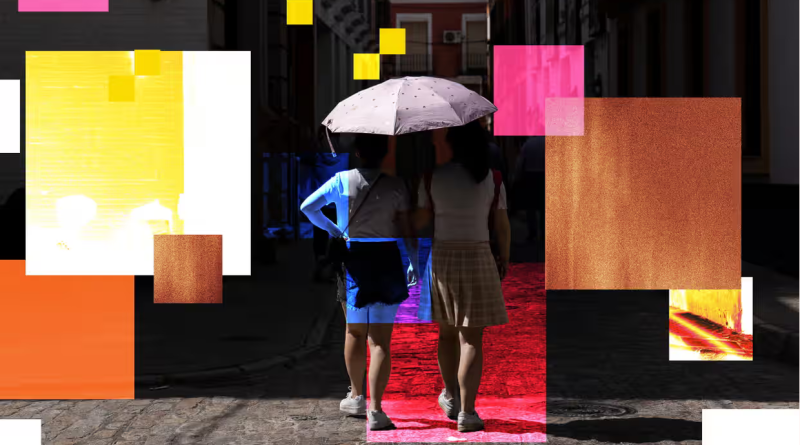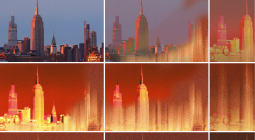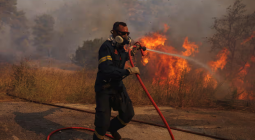Cities are tackling rising heat – but they have to avoid a dangerous trap

Heat has become a major health threat to cities, with record numbers of deaths being recorded in urban areas around the world. Composite: Guardian Design/AP
Beneath the streets of Seville – the city nicknamed “El Sartén”, the frying pan of Europe, where summer temperatures regularly top 40C – a €5m (about £4m ) cooling strategy is taking the city back in time.
The millennium-old Persian technique of “qanat” features underground channels filled with water and shafts that bring the cooler underground air to the surface. Seville is doing the same, adapting a 1992 experimental qanat to use renewable power and – in a new twist – pumping the water to the tops of buildings, where it will trickle down inside the walls to cool them. Even the benches will be chilled.
It sounds like a luxury, but it is nothing of the sort. Heat has become a leading health threat to cities, and not just in Seville. Last year 645 people died from overheating in Phoenix. Counterintuitively, the fire trucks in Phoenix now carry ice, packed into body bags. Its first responders have learned through the experiences of the past few years that you can save lives by packing overheated people into ice – a cold-water immersion therapy used in extreme endurance tests, such as military training and marathon running – in order to bring their temperature down rapidly while whisking them to hospital.
Nor is Phoenix an outlier. On this year’s hajj, the Muslim pilgrimage to Mecca, an estimated 1,300 people died in heat that surpassed 51C – more than half way to water’s boiling point, a toxic level that cooks human cells, thickens blood and cuts off oxygen to the brain. Extreme heat in New Delhi has killed more than 100 people in the last three months alone, probably a vast undercount. It is now considered unsafe to work outside at all in Doha, a factor behind the deaths of an estimated 6,500 migrant workers in the 10 years after Qatar won the right to host the World Cup.
Cities are not just where the rapid heating of our planet is highest, owing to the concentrating effect of concrete and asphalt and the relative lack of natural cooling factors such as lakes, soil or shade. They are also where our increasingly urban species will have to face it. So the architects, planners and politicians who serve those cities are seeking ways to either reduce or mitigate that heat, such as the qanat cool water beneath the streets of Seville.
Some cities now offer cooling centres, where you can escape the heat, though most people do not want to use them on a regular basis. There are policy changes that can help: laws protecting workers, heatwave response plans, and spatial mapping that can identify the hottest parts of a city.
Much is made of tree-planting, such as Singapore’s effort to seed more than 7m new trees, and of green space in general: parks and gardens can, and do, offer a huge amount of relief. Seville and other cities are installing awnings along streets for shade; LA is one of a number of places experimenting with “cool pavements”, employing a type of paint that can reduce heat up to 11C.
An increasing number of cities are experimenting with green roofs, covered in plant life, or “white roofs” like those in New Delhi, where exposed concrete is whitewashed. And the architects are letting their imaginations run wild; in Abu Dhabi, for example, Arup has designed a tower that has computer-controlled folding screens that open and close like flowers, based on the sun’s position.
Vernacular architecture is experiencing a modest revival, too: houses that dispense with air conditioning in favour of porches, cross-ventilation, pools of water and an increased permeability between inside and out are increasingly popular. City planners are remembering that cities with shady courtyards, arcades, and narrow breezy streets can protect against the sun.
They are also remembering that adobe and stone soak up heat better than concrete; so do cupolas, large windows, traditional Japanese “breezeway” corridors and traditional Indian “bowli” stepwells such as at the much-lauded Pearl Academy of Fashion in Jaipur. We used to talk about “winterising” homes; now, perhaps, we must “summerise” them.
But there is a growing anxiety that many of these ideas – which are sustainable and well thought out – are considered relatively fringe, and almost entirely rejected by the mainstream development industry as being too expensive. China recently poured more concrete in two years than the US did in the entire 20th century.
Instead, urbanists fear that far too many cities are willingly walking into the trap of air conditioning. For now let’s leave aside the fact that it is unequal (air conditioning is expensive and not available to everyone), or that it actually raises outdoor temperatures by as much as a degree or more, or that it is a big drain on energy (as the Observer’s Rowan Moore notes, the US expends more energy on air conditioning than the whole of Africa does on everything), or that it even changes the very way people live in cities, bundling from home to car to shop in separate little bubbles. The really big problem about air conditioning is that it is not a remedy but a crutch.
Yes, it can chill the “inner sanctum”, as George Monbiot calls it, for the privileged rich in leafier neighbourhoods, while peripheral communities bake. But lean on the crutch too hard and it can snap.
One of the key effects of heatwaves, which send demand for electricity soaring and cause extreme storms that stress electrical grids, is to cause blackouts. Blackouts mean no more air-con. A recent study suggested a blackout lasting just two days could hospitalise more than half of Phoenix residents and kill 12,000, mostly in their own homes. This is why the author Jeff Goodell warns of a “heat Katrina”: you thought the hurricane in New Orleans was bad?
Our reliance on air conditioning means we continue to throw up buildings that rely on it – huge blocks of inner space without courtyards or operable windows, and with continuous glass facades. The US has exported its urban model to countries where it simply does not suit the local environment, and air condition means cities now build in ways that are entirely non-responsive to place.
In 2020, Kanhaiya Manik Kare, a 41-year-old balloon seller in New Delhi in the prime of his life, collapsed and died after working outside for six hours during temperatures that hit 48C. “I went mad with grief,” said his wife, Mangla Manik Kare.
Within days she was out on the street, with her children, selling the same balloons for 10 rupees (9p) apiece. “The wind was so hot recently that me and my kids all got sick,” she said. Without savings, she had no choice but to remain out there.
Perhaps Kanhaiya could have been saved by New Delhi’s new “heat clinic”, which uses tubs full of ice – the same basic idea as the Phoenix fire department’s body bags. It can treat about 50 people a week. There are 33 million people in New Delhi.





